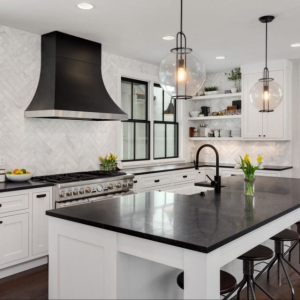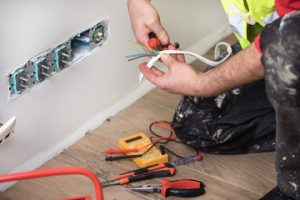Kitchen Remodeling Tacoma involves crucial alterations to the kitchen’s structure and design. It is more comprehensive than a renovation, but it can yield jaw-dropping results.
When properly executed, a kitchen remodel should increase the value of your home. It also enhances the overall aesthetic of your house and is an important factor for potential homebuyers.

A well-designed kitchen not only looks beautiful, but it also offers a streamlined workflow. At Gehman Design Remodeling, we know that the kitchen is more than just a place to cook; it’s a hub for family and friends, so creating a comfortable space is essential. Whether you’re hosting coffee dates, dinner parties, or game nights, an updated kitchen is sure to be the center of attention.
The ideal kitchen layout varies by homeowner, but there are some fundamental principles that can help you create the perfect space for your needs. For example, the classic work triangle principle focuses on positioning the sink, stove, and refrigerator in a configuration that facilitates efficient movement throughout the room. Additionally, zoning is an important concept that involves designating different areas for specific tasks to promote efficiency and streamline workflow.
Regardless of the style you want to achieve, an expert remodeler will ensure that all your new elements and fixtures work together seamlessly. They’ll consider how your home’s overall size and footprint will impact the kitchen’s functionality, and they’ll be sure to follow industry standards for safety and efficiency.
Kitchen remodeling is one of the best ways to add value to your home, and it’s a great investment for any homeowner. In fact, prospective buyers often prioritize upgraded kitchens as a primary consideration when selecting homes for purchase. With the right team on your side, you can achieve a functional kitchen that reflects your personal taste and improves daily living.
Aesthetics
Whether you want to create a sleek modern aesthetic or a warm and cozy country kitchen, you can make the space your own with materials and finishes that reflect your style. Working with a Kowalske designer, you can explore popular styles and trends that will elevate your kitchen and match the overall design of your home.
Cabinetry is a defining element of your kitchen’s design, and it can set the tone for your entire kitchen’s aesthetic. Handle-less cabinets, integrated appliances, and hidden storage solutions all contribute to a clean look. White and neutral color schemes with subtle pops of bold accents are a great choice for a timeless look.
Lighting also plays a key role in setting your kitchen’s mood and highlighting important features. Oversized pendant lights, sculptural chandeliers, and LED strip lighting under cabinets all add drama to your kitchen while illuminating work spaces effectively.
The finish of your counters, backsplash, and flooring is another factor that sets the aesthetic of your kitchen. High-end materials like quartz countertops and marble backsplashes are visually striking but require little maintenance to keep them looking new. Matte surfaces on cabinets and backsplashes are a practical option for reducing fingerprints and smudges in busy kitchens.
A well-appointed kitchen not only adds visual appeal to your home but also increases its value. Prospective homebuyers tend to prioritize properties with updated kitchens, so a professionally remodeled kitchen will make your house stand out in the competitive housing market. However, it’s important to balance aesthetics with functionality and consult a trusted remodeler to ensure your project is completed correctly.
Space
The kitchen is one of the most important rooms in a home, and it needs to be functional and attractive. If your kitchen is outdated or cramped, a remodeling project can be an excellent way to add value and create a space that meets the demands of your lifestyle.
A complete overhaul involves a major change to the kitchen’s layout, including relocating or moving walls. It’s often more costly and time-consuming than a renovation, but it can be a great investment if done correctly.
Removing walls and rearranging appliances can maximize storage capacity, improve workflow, and enhance functionality. A remodel can also address aesthetics and design, incorporating new cabinets or a fresh paint job to refresh the overall look of your kitchen.
Kitchen cabinets are a focal point of any kitchen and can make or break your design. Choose a color and style that suits your space and expresses your personal style. You can also add a unique touch by choosing custom cabinetry to accommodate special spaces or specific storage needs.
Kitchen backsplashes are another important element of kitchen design. Choose a material that balances visual appeal with durability and maintenance requirements. Natural stone like marble and granite are popular, but other options such as quartz and soapstone are gaining popularity for their durability and timeless beauty.
Energy Efficiency
Many homeowners want to update their kitchens with more energy-efficient appliances and lighting. Embracing energy-efficient options not only cuts utility bills, but it also enhances the overall comfort of the kitchen by reducing noise levels and temperature fluctuations. Additionally, energy-efficient kitchens are highly desirable among homebuyers, which can help increase your resale value.
Understanding the differences between remodel and renovation can help you make the right choice for your Temecula kitchen upgrade. Remodeling involves significant alterations in the structure and design of your kitchen, including changing the layout and creating a different aesthetic. On the other hand, renovation focuses more on refreshing surfaces and replacing fixtures with modern alternatives.
Energy-efficient kitchen remodeling typically focuses on improving the efficiency of your appliances and plumbing. For example, replacing your refrigerator, oven, and dishwasher with models labelled with the Energy Star label can reduce your electricity usage by 10-50%, resulting in substantial savings on energy bills. Similarly, upgrading your light bulbs to LEDs or CFLs reduces energy consumption and generates 75% less heat while producing brighter, more natural-looking light.
Alternatively, installing a smart thermostat can ensure that your home maintains a constant, comfortable indoor temperature without overusing energy-consuming heating or cooling systems. Likewise, investing in a hot water recirculation system can significantly reduce the amount of time you spend waiting for your tap to fill up.
Moreover, you can also boost your kitchen’s energy efficiency by opting for green construction materials such as bamboo flooring and recycled glass countertops. These are durable and eco-friendly, so you can enjoy your new kitchen for years to come while minimizing environmental impact. Additionally, you can choose environmentally friendly finishes and paints that will reduce the amount of toxic chemicals released into the environment.
Safety
When it comes to kitchen remodeling, safety is an important consideration. This is because the kitchen is often a busy area where people are moving about and using various appliances. As such, it’s easy for accidents to happen, especially if you aren’t careful. There are several things you can do to make your kitchen remodel safe for everyone in the house.
First and foremost, it’s essential to use the proper tools for the job and follow all instructions and safety guidelines. This includes unplugging appliances before making modifications, handling sharp tools with care, and storing them securely when not in use. Also, it’s crucial to have adequate ventilation in the kitchen to reduce fumes and odors.
Another important safety measure is to design a safe floorplan. For example, avoid putting a stove near an entrance or exit, and be sure to situate microwaves at heights that don’t require reaching across hot surfaces. It’s also a good idea to include slide-out trays and bins in base cabinets. These features make it easier to retrieve items and minimize the need to reach and twist. In addition, consider using rounded corners on countertops to avoid injury to children.
Surviving a kitchen remodel can be challenging, but it’s possible with a little planning and flexibility. By staying close to your contractors, communicating frequently, and prioritizing health and safety, you can minimize disruptions and enjoy a safer, more functional kitchen.




